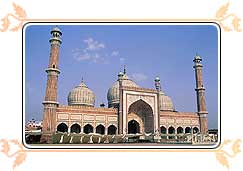| Location: | Old Delhi |
| Built By: | Shah Jahan |
| Jama Masjid Timings: | 7.00 a.m - 600 p.m (Summer) / 8:30 a.m - 5:00 p.m (Winter) |
| Jama Masjid Facts : | Described as the most beautiful mosque in India |
Jama Mosque
The splendid Jama masjid was built by Shahjahan in 1656 in the typical Mughal style with two minarets and three domes, lies to the west of the Hussainabad Imambara and is entirely free from pseudo Italian art then in vogue in Lucknow. Though Shah Jahan has the credit of building a number of mosques in Delhi, Agra, Ajmer and Lahore, the Jamamasjid or Jami masjid is by far the best and an outstanding symbol of Mughal architectural brilliance in India.

It is the country's largest mosque, where thousands of Muslims offer prayers. It lies opposite the Red Fort and is surrounded by a large number of shops, which deal in a variety of goods. The great mosque of Old Delhi is both the largest in India and the final architectural extravagance of Shah Jahan with a courtyard capable of holding 25,000 devotees.
Jama Masjid Location
This congregational mosque stands in the city of Delhi. Built in yellow sandstone, it combines the best of Hindu and Muslim styles of architecture, standing on 260 pillars supporting 15 domes at varying elevations.
Jama Masjid History
Jama Masjid is the largest mosque in India and stands across the road from the Red Fort, built in 1656 by Shahjahan. About 25,000 people can pray here at a time.
Jama Mosque Architecture
The vast paved courtyard is a rectangle nearly seventy-five metres by sixty-six metres. The whole of the western chamber is a big hall, standing on 260 pillars all carved from Hindu and Jain traditions. The central courtyard is accessible from the East, though there are three ways on the other side too. The Eastern side entrance leads to another enclosure containing the mausoleum of Sultan Ahmed Shah. Thus it is an architectural triumph.
Tombs
Near the Eastern entrance stands the 'roja' or the tomb of the Sultan Ahmed Shah, which was homage to the Sultan by his son Mohammed Shah II. The tomb houses the graves of three great rulers of Gujarat - Ahmed Shah I, his son, Mohammed Shah and his grandson, Qutub-Ud-Din Ahmed Shah II. After a passage of 100 years, a nobleman by the name - Farhatul Maluk repaired the tomb, who also got the walls of the mosque engraved. Today after centuries of heat and rough weather, the Masjid stands unchallenged serving as a prayer place for numerous Muslims residing in the city. Among the most popular sights of the city of Ahmedabad is the Jama Masjid, boasting of a well-proportioned architecture. It took 13 years to complete this fine example of Indo-Saracenic architecture of the Ahmed Shahi style. A white marble paved courtyard, with a pool in the middle provides a perfect pause between the raucous streets outside, and the dignity of the main sanctuary within. Nearby the Masjid are Pols and the Teen Darwaza (The Three Gates) which were meant as the royal entrance to the Maidan Shah or Royal Square. From here the Sultans used to watch the processions from the palace to the Jama Masjid.
Main Imam
The main imam of the Jama Masjid or we can also say old Jama masjid is the direct descendent of the original and first Imam appointed by Emperor Shahjahan and till now there is no break in its descendency. People of other religions are not allowed in between 12-30 and 2-00pm. One is allowed to enter the mosque bare-footed, head covered and wearing lungi, - these are the norms visitors have to follow and are available on payment. For taking images of Jama Masjid or Jama Masjid pictures one has to buy tickets first. For more info Jama Masjid map will help you.